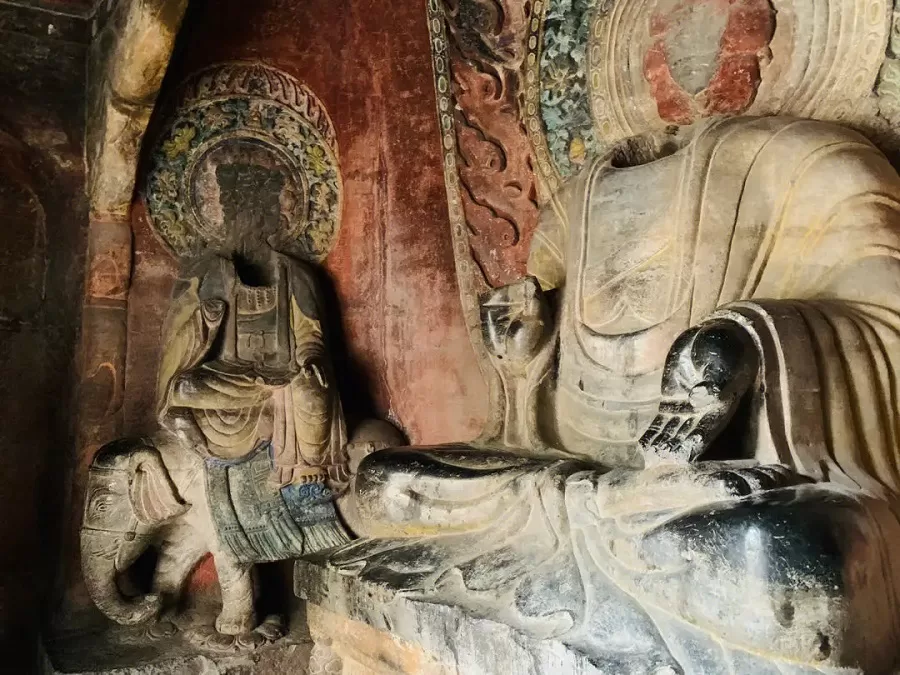Nestled in the southernmost part of Hebei Province, China, in the Fengfeng Mining District of Handan City, lies a remarkable treasure of ancient Chinese art and Buddhist heritage – the Xiangtangshan Caves (响堂山石窟), also known as the Xiangtang Grottoes. These caves are renowned for their unique location and the harmonious blend of architecture, sculpture, and spiritual significance that they hold.
The Xiangtangshan Caves are divided into two main sections, situated approximately 15 kilometers apart. Their name, which translates to “Echo Hall Mountain Caves” in English, is derived from the distinctive echoing sound produced when people talk, laugh, or move within the caves due to their location on the mountainside.
The history of Xiangtangshan Caves dates back to the Northern Qi dynasty (550-577 AD). Over the centuries, subsequent dynasties, including the Sui, Tang, Song, Yuan, and Ming, contributed to their expansion and development. Today, visitors can explore 16 caves adorned with over 4,000 sculptures and numerous inscriptions, including sutras and dedicatory inscriptions.
Table of Contents
- Basic Information
- Location and Transportation
- Origin of the Grattoes
- Subsequent Expansion
- Features of the Statues
- Carving Techniques
- Video about Xiangtangshan Caves
- Useful Tips Summarized from Reviews
- Other Attractions in Handan
Basic Information
| Estimated Length of Tour | 3 hours |
| Ticket Price | Northern Caves: 60 RMB Southern Caves: 15 RMB Shuttle Bus: 40 RMB |
| Opening Hours | 8.00 – 17.30; Last admission: 17.00 |
| Telephone Number | 0086-0310-5050222 |
Location and Transportation
Xiangtangshan Caves are situated in the Fengfeng Mining District of Handan City, in Hebei Province, China. This location, though somewhat remote, is accessible by public transportation from the nearby city of Handan.
- To reach the Southern Xiangtangshan Caves, you can take a bus from Handan West Station to Pengcheng City and alight at Nan Xiangtang. Alternatively, you can catch bus number 5 from Handan East Station and get off at Nan Xiangtang Station.
- For those interested in visiting the Northern Xiangtangshan Caves, you can board bus number 4 within the city of Handan and disembark at Bei Xiangtang.
Origin of the Grattoes

During the Northern Qi period, the region was strategically located between the capitals of the dynasty, Ye (modern-day Handan) and Jinyang (modern-day Taiyuan). The natural beauty of Xiangtangshan, with its clear waters and excellent stone quality, caught the attention of Emperor Gao Yang, a devout Buddhist. He ordered the excavation of the caves, the construction of a palace, and the establishment of Buddhist temples to provide a place for retreat, leisure, and religious devotion while traveling between the two capitals. Although the emperor’s palace has long since vanished, the Buddhist sculptures carved into the rock face have endured the test of time.
Subsequent Expansion

Beyond the Northern Qi period, subsequent dynasties continued to contribute to the caves. The Sui, Tang, and Ming dynasties collectively excavated six more caves, though on a smaller scale. Both the Northern and Southern sections of Xiangtangshan Caves boast auxiliary architectural structures. Beneath the Northern Xiangtangshan Caves, the ruins of the Changle Temple span 7,000 square meters and house a Song dynasty pagoda, scripture pillars, and stone inscriptions dating from the Song dynasty to the Republican era. Near the Southern Xiangtangshan Caves, there are Song dynasty pagodas, pavilions, and halls.
Features of the Statues

The sculptures in Xiangtangshan Caves exhibit a unique style characterized by robust and solid forms, reflecting the vigor and boldness of the Northern Qi people. The figures have slightly rounded faces with high noses and long eyes. Many are seated in either the full or half lotus position on a pedestal resembling a lotus flower. The garments are adorned with intricate and irregular patterns, with the lower hem of the robes neatly arranged on the pedestal. An example can be found in the seventh cave of the Southern Xiangtangshan Caves, where a bodhisattva is depicted with a round and full face, a strong and well-proportioned body, a slightly raised abdomen, and ornate garment patterns, wearing a draped robe on the upper body and a large skirt on the lower body, which clings to the form.
Carving Techniques

The carving techniques employed in Xiangtangshan Caves blend elements from the Northern Wei period with innovative approaches. During the Northern Wei era, sculptures were predominantly created using a straight chisel technique, resulting in stepped patterns on the garments, giving them a simple, rugged, and somewhat rigid appearance. However, at Xiangtangshan, this technique was blended with the use of a round chisel, particularly evident in the transitions of the garment folds. This combination created a more rounded and lifelike appearance, enriching the sculptures with realism and grace.
Video about Xiangtangshan Caves
Useful Tips Summarized from Reviews
Included Sites in Ticket Price: The digital exhibition hall and the ruins of Changle Temple at North Xiangtangshan are highly recommended and are included in the admission fee.
Observation Car at North Xiangtangshan: It is advised not to take the 40 yuan sightseeing car at North Xiangtangshan since it only covers a short distance to the base of the stairs for climbing.
North Xiangtangshan Cave Highlights: Noteworthy caves at North Xiangtangshan include the Grand Buddha Cave, Shakyamuni Cave, and the Sutra Engraving Cave, all of which are described as impressive.
Condition of South Xiangtangshan Caves: The caves at South Xiangtangshan have suffered significant damage, with only the Huayan Cave relatively well-preserved.
Optimal Lighting for Photography: It is recommended to visit North Xiangtangshan in the afternoon when the sunlight shines through the cave entrances onto the Buddha statues, creating excellent photographic opportunities.
Estimated Visit Duration: Plan approximately 3 hours for exploring North Xiangtangshan and around 30 minutes to 1 hour for South Xiangtangshan. The two cave sites are 15 kilometers apart.
Sequential Viewing at North Xiangtangshan: Suggested route at North Xiangtangshan is to view the caves from left to right, allowing for a natural descent after completing the visit.



